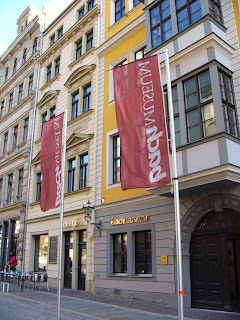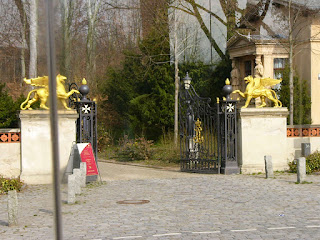In the true spirit of a Robin and Jenn vacation, we decided that we could see both Wittenberg 1 1/4 hours southwest of Berlin and Leipzig, another hour farther southwest all in one day.
Public transportation in Germany has been phenomenal and Robin and I are getting quite good at reading the time tables, negotiating connections and buying tickets.
Wittenberg is the adopted hometown of Martin Luther and the birthplace of his protestant reformation. Since we only had two hours between train connections, we quickly found a cab to take us to the outermost part of the old town where we started our whirlwind tour at the Schlosskirche or Castle Church.
The original church was destroyed in 1760 and wasn't rebuilt until the late 19th century when Germany was united for the first time. It was here on October 31, 1517 that Luther nailed his 95 thesis to the door.
At the time the original church was built, the interior was only open to the common public on All Saints Day. I was wondering if this accounted for the reason the interior was more lavishly decorated than the subsequent church we visited.
Inside we were able to see the tombs of both Luther and Philipp Melanchthon, Luther's fellow professor. There were also two larger tomb markers for the Wittenburg princes who supported the reformation. I am always fascinated by the ceilings of large cathedrals. The nave of the Schlosskirche is lined with the coats of arms of the German cities that became Protestant when they joined Luther's reformation.
Upon leaving town, we continued to walk along the cobblestone street to the town square. The street is lined with small, shallow canals that would have carried fresh water into the town and sewage out of the town during medieval times. Our walk along this rode was quite pleasant and charming but I suspect it wasn't always this way.
Our next stop was at the Stadtkirche St. Marien or the Town Church of St. Mary's. This is the oldest building in Wittenberg and Luther's home church where he preached over 2,000 times. Unfortunately, the exterior of the church was undergoing heavy renovations and much of it was covered in scaffolding. The interior was quite plain in comparison to the Schlosskirche. However, both contained impressive pipe organs.
Our final stop in Wittenberg was the Lutherhaus, or Luther House in English. This was the monestary where Luther lived as a monk and then later, his resiedence with his family and school for his pupils. The Lutherhaus is now a museum with many original paintings, manuscrips and other church artifacts. I particularly enjoyed Luther’s original translations of the Bible from Latin into German. We could see his actual notes in the margins of the hand written pages.
In comparison to Berlin and Potsdam, Wittenberg was a very small and quiet town. The main road was closed to traffic and there was a market set up in the town square. Many residents appeared to travel by bicycle and the cafes were quite crowded on this beautiful March day. The Lutherhaus was only a short ten minute walk to the Hauptbanhnhof or train station and we made it back in plenty of time to catch our train to Leipzig.
Traveling through the German countryside, I was surprised at the amount of open farmland. It appears that Germans (at least in the east) are very environmentally conscious. Groups of windmills dotted the countryside and we were told that many people don’t even own cars.
Traveling through the German countryside, I was surprised at the amount of open farmland. It appears that Germans (at least in the east) are very environmentally conscious. Groups of windmills dotted the countryside and we were told that many people don’t even own cars.
Leipzig is the home of many famous Germans, namely the writer Goethe, and musicians Bach, Mendelssohn and Wagner. The Leipzig Hauptbahnhof is one of the biggest train stations in all of Europe but it was well marked and easy to navigate. Thankfully, I’m finding that transportation hubs all over the word, including the US, use the same symbols on their signage so finding our way through the German hauptbahnhofs has been no different than getting through Penn Station in New York.
The majority of the sights in Leipzig are located within the ring road of the medieval town. Leipzig is more along the lines of what I expected to find of a European city - narrow, winding streets with taller buildings not allowing sunlight to reach the road.
We started at Nikolaikirche, or St. Nicholas Church. Built in 1165, it is Leipzig’s oldest church. In the 1980’s the church was the site of weekly prayer meetings which gradually became a forum for people to voice their anti-communist opinions. From these prayer meetings sprung the Peaceful Revolution which eventually toppled the communist regime. I was more interested in visiting the Nikolairkirche to see the interior which consisted of ornate columns with fingers that appeared to support the ceiling.
Next we stopped at the Zeitgeschichtliches, or Contemporary History Forum. The exhibit was on Mosaik, the comic book produced during the DDR regime. The exhibit was largely in German so it was a little difficult to understand, but I get the impression that Mosaik often mocked the DDR and the harmless children’s comic strip was really a forum for biting political commentary.
Just down the street was the Thomaskirche or St. Thomas Church. Bach spent much of his career here conducting the boys’ choir. Martin Luther introduced Leipzig to Protestantism at this church in 1539. In front of the altar is a tomb where what historians believe to be Bach’s remains are interred. As Robin and I learned in an e-mail from her brother AJ, Bach was not famous during his own time and he died almost a pauper. If it were not for Mendelssohn’s efforts in preserving Bach’s legacy, he may have been largely forgotten from history.
Bach was buried in a humble graveyard and when his music was rediscovered in the 19th century, aficionados exhumed three corpses that could have been Bach and compared them to portraits in an attempt to find the real Bach. The organ is new, from 2000. While we were in the church we were fortunate enough to hear someone playing the organ.
Next to the church was the Bach Museum which had wonderful interactive exhibits, likely designed with children in mind, but Robin and I also found them quite entertaining.
The remainder of the evening, we wandered around the old town of Leipzig seeing the Altes Rathaus or Old Town Hall and Madler Passage where the statues enact a scene from Goethe’s Faust which was set here. Dinner was at the Brauhaus which were becoming our favorite types of restaurant in which to eat, before heading back to the Hauptbahnhof. On our way back to Berlin, we changed trains in Dessau, the home of the Bauhaus. I would have loved to visit the Bauhaus but I guess we can only fit so much into four days.
























































